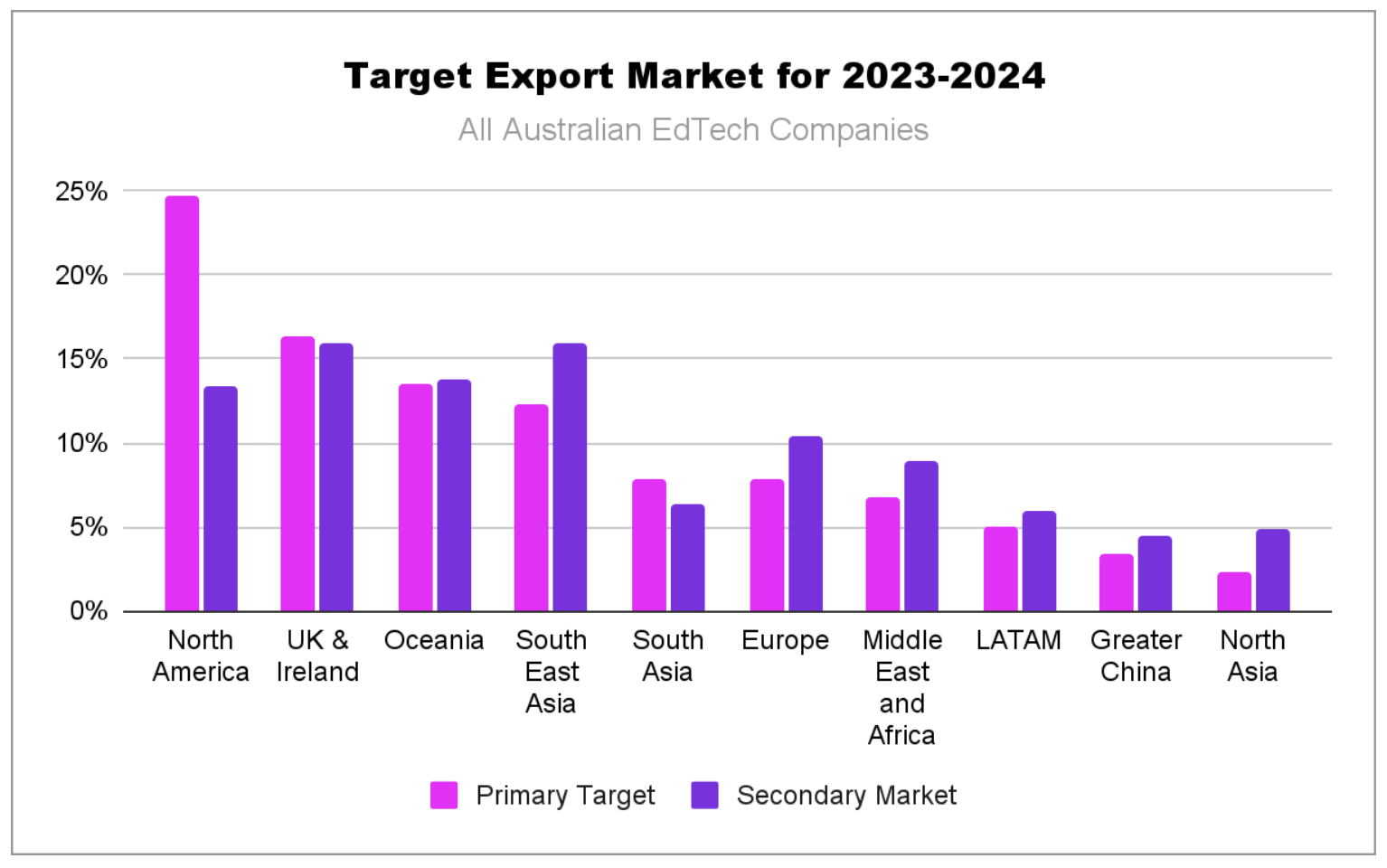Every Australian EdTech company that generates more than $4M of revenue exports products and services around the globe. Scaling EdTech companies generate 13% of their revenue offshore, whilst the biggest companies generate an average of 37% from export. These companies are impacting learners across the globe using Australian education in a digital form.
The markets of interest to Australian EdTech companies can best be summarised as Established EdTech Companies Stay Close to Home, Whilst Emerging EdTech Companies Seek English Speaking Markets.
Australian EdTech companies seek out English speaking markets in their first global steps. The desire to maximise returns from existing products drives them to the global markets in the USA and UK.
Australian EdTech companies have a clear competitive advantage; 73% of them focussed on B2B sales and supporting the digital transformation of education providers. This contrasts with the EdTech ecosystems of our close neighbours where the majority of EdTech companies focus on direct-to-learner, or business-to-consumer (B2C) go-to-market models. Australian EdTech companies are well placed to support the system-wide and institutional deployment of EdTech in the UK market.

Key Considerations on Building Export Sales
Australian EdTech companies look beyond our shores to scale their businesses, but that export strategy needs well developed strategic planning that leverages existing competitive advantage along with appropriate resourcing. Many EdTech companies in their first export steps use a scatter-gun approach to export market development driven by inbound enquiry, not driven by well defined strategy.
The key consideration to export market sales is an assessment of current operations.
- Are you mature in your current market?
- How much funding do you have to support export sales without revenue from that market?
- Who within your organisation will lead the export sales within a defined territory?
- Have you completed a market assessment for your product or service?
- Do you know the key in-market experts, both Government and commercial, that can support your strategic planning?
- Have you researched the industry-bodies for EdTech within the export markets of choice?
- Have you defined the onboarding and support model for your export market
Product-Market Fit or Leveraging Strategic Capability
Your key consideration is defining why you are seeking export markets. Have you made a strategic decision that aligns to your strategic plan, or are you chasing commercial traction in any market where you can make a sale?
Most successful exporters in the education sector leverage competitive advantages from their home market when entering new markets. Showing commercial traction in your home market is key to finding that first customer in a new market. It is challenging to close sales in new markets if you can’t show traction in your home market; don’t underestimate the significant challenge in closing your first customer in an export market.
Bring a Founders Mindset
As an EdTech entrepreneur you know how incredibly challenging it was to find commercial traction in Australia. So pause and reflect on the steps in your journey from EdTech idea to first customer, then to scaling and most importantly how many immediate decisions you needed to make. You may have forgotten how many times you pivoted, how you rapidly changed pricing, how you rebuilt the support model, how your onboarding process matured and how non-linear the trajectory was. All these complications apply to your new export market, but now your mature business should have many components to support this strategic move. Many successful EdTech exporters appoint a founder to lead new market entry, or at a minimum delegate significant decision making to the executive leading that market entry.
Consider Sub-Markets
When you started your EdTech business you found an entry point to domestic sales, which allowed you to show traction, test product positioning, refine pricing and build a replicable sales model. All these considerations now apply to your export strategy.
Consider the separate, but connected, components of your chosen export market. Consider the discrete segments of the market, those that might be easier to sell to, or have advantages in adjacent markets. Consider different positioning, or product offerings.
Sub-market examples for consideration:
- International Schools – if you sell to K12 schools, consider the international school market as separate to the local schools and across geographic borders.
- International Baccalaureate – Consider the regional, national or international accrediting bodies that operate in the segments you seek to serve, which are distinct from your home market.
- University Partners – If you sell to universities, consider the relationships your customers in Australia have across your target country or region, seek referrals from your advocate customers to their partners across the region.
- Academics – Australia has an array of globe leading academics that are well connected internationally, consider the role they can play in your export strategy, how can you build a partnership that connects to the academics strategic plans.
In-Market Expertise and Consultants
Very few Australian EdTech companies actually utilise the resources available to them, nor strategically plan to engage them in their export market strategy. The Australian Government, and each of the states and territories, have well developed trade and investment agencies with significant market intelligence and in-market relationships that are available to you.
The Australian economic development teams across the globe, whether employed by Austrade, Investment NSW or other state governments, are at your disposal. These teams have key performance indicators that directly align with your export strategy, they need you as much as you need them; a perfect partnership. Build long term strategic engagement plans with the economic development agency staff in your key export markets; treat them as you would any strategic stakeholder – give them regular strategic updates on your activities in-market and the success metrics that allow them to report their success in helping you.
Government funded trade programs are low-cost, high value programs that will advance your understanding of an export market and provide immense insights for your strategy. Ensure you complete all feedback surveys requested of you before and after the trade mission. Proactively update the government agency staff every 6 months for the next 2 years following the trade mission to update them on the export development your company has seen since the mission began. The implied contract on trade mission participation is to show the impact of the mission now and into the future, be proactive with that information and understand that your traction is essential to ongoing government support for the broader sector into the future.
Don’t Go It Alone
The Australian EdTech ecosystem includes the EdTech companies themselves, the education providers and the key industry stakeholders. All these actors can be part of your export strategy; but success takes planning and engagement.
Australia’s education sector is respected across the globe. All Australian governments have spent considerable funds marketing Australian education to the very markets you are seeking for export sales. Use these facts as leverage for your export market strategy; complete case studies with your local advocate customers, and engage them to share their success with your product at conferences in your target audiences – they are more likely to get a free speaking slot than your business development director.

Fill out this form to download the full Building EdTech Export Sales Report.
"*" indicates required fields

